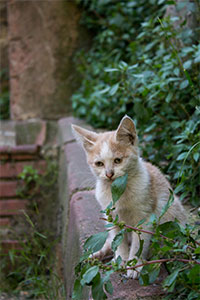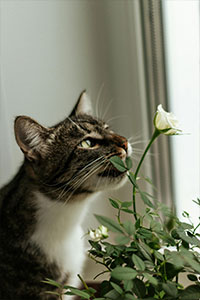Jessica W. Kelvin - Mar.05.2024
Why Do Cats Eat Grass?
7 Insights into Feline Behavior

Written by Vinh Trinh| DVM|4.3.24
Why Cat Toilet Training Isn’t a Good Idea
Est. read time: 6 min.
MMany of us have daydreamed about the prospect of losing the litter box altogether. After all, some cat parents have succeeded at cat toilet training, haven’t they? The idea in theory may sound convenient, sophisticated, or just plain funny. We’ll cover why cat toilet training is not recommended by vets and animal behaviorists—for health, behavioral, and environmental reasons.
Behavioral reasons
Cats instinctively know how to use the litter box. This biological drive stems from their desert ancestors, who covered their waste to avoid detection by predators. These wildcats gravitated toward soft dirt or sand, since the granular consistency made it easier to bury their waste. This is why cats are naturally attracted to the feel of cat litter.
Cat toilet training essentially forces your cat to suppress their most basic instincts of digging and burying waste. This will lead to unnecessary stress, likely impacting your cat’s behavior in other ways. You may end up with accidents around the house (including on your favorite Persian rug), or, worse, a cat that has developed anxiety issues.
As Jackson Galaxy, aka The Cat Daddy says, “I'm all about making your cats the best version of themselves. But that doesn't mean making them more human.”

Health reasons
If you manage to succeed in cat toilet training, you’ll no longer be able to monitor an important aspect of your cat’s overall health: their litter box habits. This includes monitoring the contents of the litter box, as unpleasant as the task sounds. When it comes your cat’s litter box, you should be paying attention to:
-Frequency of urinating and defecating: Increased urination (or straining to urinate) may be a sign of a urinary tract infection (UTI), while decreased urination could lead to feline idiopathic cystitis (FIC) or a life-threatening feline urethral obstruction (FUO).
-Clump size: Large clumps may be a sign of kidney disease, hyperthyroidism, or diabetes.
-The absence of clumps: Again, this could be a sign that your cat is experiencing urinary issues.
-Blood in the litter box: Blood is most likely a sign of FIC, FUO, a UTI, or (rarer) bloody diarrhea.
-Worms in the litter box: Gastrointestinal parasites occur in cats that have not been appropriately dewormed, and are very common in young kittens.
Early detection of such issues goes down the toilet, as it were, if you’re unable to observe your cat’s litter box habits.
Accessibility
Accessibility is another important health consideration when deciding whether cat toilet training is right for your pet household. Most pet parents have no idea how prevalent arthritis in cats is. If an aging cat must jump to the height of a toilet and either straddle or balance precariously over the bowl, this may cause enough additional strain on their joints to warrant future accidents (including the potential trauma of falling into toilet water)—not to mention unnecessary pain.
Furthermore, your cat may be too small or impaired by other health issues to effectively use a toilet. Going to the bathroom is a basic necessity for your pet, as it is for any living creature: Don’t make it more difficult than it needs to be.

Environmental reasons
Cats are almost notoriously known for contracting the common parasite Toxoplasma gondii (usually from eating raw meat or from contaminated soil) and shedding it in their feces. So, say your cat has toxoplasmosis and defecates into a toilet: Preventive Vet explains that typical wastewater treatments that flushed water goes through do not kill the disease. This unfortunately means that the parasites “wind up in local lakes, rivers, streams, and other bodies of water, where they can infect and kill seals, otters, and other water-dwelling wildlife.”
Can you flush cat litter?
Even if you’ve already given up on the idea of cat toilet training, you may still wonder if you can flush cat litter. While there are flushable cat litters that aren’t supposed to clog up plumping like traditional cat litter, you’ll still want to consider the environmental aspects of doing so. If you are fairly certain that your cat has no reason to be carrying toxoplasmosis (for example, they are indoor-only, never eat raw meat, and haven’t caught live vermin in the house), then you can be more confident that flushing cat litter won’t have a negative effect on the environment.
Practical reasons
Finally, let’s examine the practical reasons for not engaging in cat toilet training:
-Lids up or down – Not everyone wants to live in a household with toilet lids up all the time. But if you have a cat trained to use the toilet, you’ll need to make sure you’re doing just that! Be mindful of other pets in the house (dogs, most likely) drinking out the toilet bowl.
-Flushing – Cats have been successfully trained to go in the toilet, but they’re very rarely trained to flush. With your cat’s waste floating in the bowl until someone notices, you again face the risk of your dog having access—not to mention the lingering odors.
-Travel – Training your cat to use one toilet doesn’t mean they’re automatically trained to use any toilet. If you ever need to travel with your kitty, you’ll likely realize that a litter box is the much more reliable option.

Now you know why cat toilet training isn’t a very good idea. If you’re tired of scooping the litter box, try a self-cleaning litter box like VIVIDMOO. This WiFi-enabled, automatic litter box is a mostly hands-off solution that only requires attention when the waste drawer is full. Simply remove the full waste drawer liner (giving a quick inspection of the contents, as discussed in “health reasons” above) and replace it with a new liner. Because VIVIDMOO cycles automatically within minutes of your cat using it, you won’t have to worry about lingering odors or your dog treating himself to a snack. Best of all, kitty has reliable access to their bathroom at all times!
Cats:Theobromine Toxic Consumption
Most Cats: 1-10 lbs(0.45-4.6 kg), Large Cats11-25 lbs(5-11.4 kg)
Cacao Beans: Most Cats> 0.05 oz, Large Cats> 0.5 0z
Unsweetened Baking Chocolate: Most Cats> 0.2 oz, Large Cats>2 0z
Dark Chocolate: Most Cats> 0.5 0z, Large Cats>7 oz
Milk Chocolate: Most Cats>1.5 0z, Large Cats>16.5 0Z
White Chocolate: Most Cats>360 oz, Large Cats>4000 0z
Cocoa Powder: Most Cats> 01 0z, Large Cats>10z
Cocoa Bean Mulch: Most Cats>0.1 0z, Large Cats>1 0z

Showing making procedure is a good way to guarantee product quality
Stress Relief
Eating grass can also serve as a form of stress relief for cats, providing a calming activity that distracts from anxiety or boredom.


Get customer attention by clean visual and video
Instinctual Actions
Grass eating is an instinctual behavior that may stem from a cat's need to seek out alternative food sources or to induce vomiting to clear their stomachs of indigestible materials.
Article credit: Heidi Cohen (https://heidicohen.com/use-blog-to-sell/)
Digestive Aid
Grass acts as a natural laxative, helping cats pass hairballs or other indigestible items through their digestive tract more easily.
Elimination of Parasites
It's also theorized that grass eating may help cats eliminate intestinal parasites, although this benefit is more anecdotal than scientifically proven.
How to Safely Introduce Grass to Your Cat
Suitable Types of Grass
Certain types of grass are more beneficial and safer for cats, including wheatgrass, which is often sold as "cat grass."
Growing Your Own Cat
Grass
For the safety and health of your cat, consider growing your own cat grass at home. It's a simple and effective way to ensure they're getting a safe product.
Alternative Behaviors and Solutions
Dietary Supplements
If your cat shows an excessive interest in eating grass, it might indicate a dietary deficiency. Consult with a veterinarian about supplementing your cat's diet.
Behavioral Enrichment
Providing toys, climbing structures, and engaging activities can reduce your cat's inclination to eat grass by offering alternative forms of stimulation.
Why Do Cats Eat Grass?
Exploring the curiosity behind this behavior reveals a complex blend of nutritional, psychological, and instinctual factors. Understanding these can help cat owners provide better care and enrichment for their feline friends.
Owner Experiences and Advice
Personal Anecdotes
Many cat owners have observed their pets eating grass and have noted the benefits or concerns that came with it. Sharing these experiences can offer valuable insights for other pet owners.
Expert Recommendations
Veterinarians and animal behaviorists can provide professional advice on managing grass-eating behavior, ensuring it remains a safe and positive experience for your cat.
FAQs
Cats should not eat chocolate ice cream; not only is chocolate toxic to cats, but ice cream often contains toxic ingredient propylene glycol. Ingesting propylene glycol can lead to anemia in cats.
Say it at the end
Understanding why cats eat grass sheds light on their complex behaviors and the natural instincts that drive them. By providing safe, suitable grass and paying attention to the underlying reasons for this behavior, cat owners can ensure their feline companions lead happy, healthy lives.












